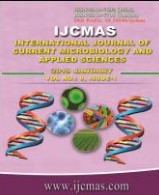


 National Academy of Agricultural Sciences (NAAS)
National Academy of Agricultural Sciences (NAAS)

|
PRINT ISSN : 2319-7692
Online ISSN : 2319-7706 Issues : 12 per year Publisher : Excellent Publishers Email : editorijcmas@gmail.com / submit@ijcmas.com Editor-in-chief: Dr.M.Prakash Index Copernicus ICV 2018: 95.39 NAAS RATING 2020: 5.38 |
The experiment was carried out during kharif 2014 at College of Agriculture, Indore under All India Coordinated Cotton Improvement Project in Randomized Block Design (RBD) with eight treatments and three replications on Bt cotton hybrid NCS 927, sown on 27th July with 0.6x0.6 m spacing. The recommended agronomical practices were adopted properly. Each treatment was prepared for alternate use of two insecticides during six sprays. The spraying was done at 10 days interval with 500 litre water per hectare, sprayed by knapsack sprayer fitted with a duromist nozzle. These treatments were marked as T1- Imidacloprid (70%WG) @ 24.5 gai/ha & Oxydmeton methyl (25%EC) @ 250 gai/ha, T2- Thiaclorprid (21.7%SC) @ 30 gai/ha & Dimethoate (30%EC) @ 250 gai/ha, T3- Imidacloprid (17.8%SL) @ 25 gai/ha & Acephate (75%SP) @ 250 gai/ha, T4- Imidacloprid (30.5%SC) @ 26.25 gai/ha & Thiamethoxam (25%WG) @ 37.5 gai/ha, T5- Spiromesifen (22.9%SC) @ 144 gai/ha & Deltamethrin (2.8%EC) @ 15 gai/ha, T6-Fipronil (5%SC) @ 100 gai/ha & Lambdacyhalothrin (4.9%EC) @ 15 gai/ha, T7- Acetamiprid (20%SP) @ 30 gai/ha & Difenthiuran (50%WP) @ 300 gai/ha and T8- Untreated check. Except third spray, in all the sprays T5 reduced maximum thrips population and found at par with T6. The highest population reduction was also noted in T5 (77.78%) followed by T6- (76.94%). The population of whitefly was lowest after each spray in T2- and showed no significant difference with T3 except in 6th spray. The similar trend was observed in population reduction also in T2 (76.69%) and T3 (72.20%).
 |
 |
 |
 |
 |